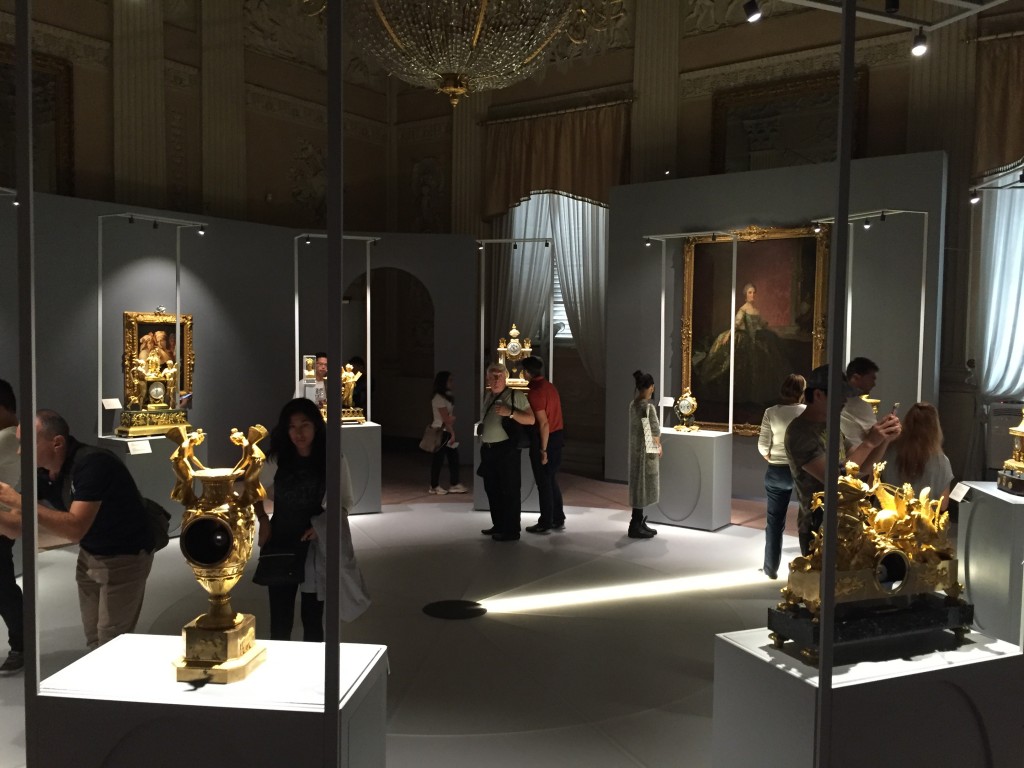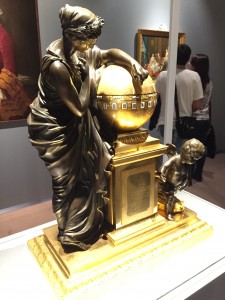By Rachyl Grussing
Leonardo da Vinci once said, ‘Time stays long enough for anyone willing to use it’. For those who are willing, the Modern Art Gallery at the top of the Pitti Palace has a new exhibit entitled ‘Real Time and the Time of Reality: Clocks of the Pitti Palace from the 18th to 20th centuries’. It features over 60 of the 200 clocks that reside in the Pitti’s collection. The idea of the exhibition, as stated by the exhibition, is to draw parallels between the arts and the sciences at this time. Artworks and artifacts from the Medici collection and items borrowed from the Galileo and Stibbert museums are displayed alongside the clocks to give them historical context. Featured in the exhibit is a tall grandfather clock to small brooch watches, a gilded and engraved weight-driven clock, and a replica of Galileo’s astrolabe.
Clocks were intricate machines that required years of training to create and lended credence to the prestige of their owners, yet at the same time, their evolution into pieces of art went hand in hand with the artisan nature of their creation. The grand 1821 Viennese Orchestrion in comparison with ‘Brooch Clock’ of 1902 show the advance of technology in a way that is hard to explain with only words. The exhibit gives the visitor an inside look at the clocks and the science behind their mechanisms, going so far as to have a glossary of clock parts on one of the walls. Thankfully, the importance of the mechanisms inside has not diminished over the centuries. The clocks have been handled by experts trained in the maintenance of clocks, and therefore are seen in the fullness in which they were made.
The exhibit starts with a film giving a backstage look into the gears and pins that make up the interior mechanism of the clock. The video is mesmerizing, all whirling gears and tinkling chimes, giving the sense that the machines within have not only served as silent witnesses to the passing of time, but lived the endless ages as well. The sense continues into into the gallery, where there is a slightly raised platform of pale purple. While the stated purpose was the follow science and art hand in hand, the focus of the exhibit seems to be on the passage of time. Every five seconds a shaft of light inlaid in the platform ‘ticks’, mimicking the hour hand of a clock. This continuous circling of light gives the impression that time is its own master in these rooms. The clocks themselves are set onto pedestals, of the same pale purple as the floor, on the edge of the lighted platform, which give the viewer a chance to see them from every angle, something the original makers and owners probably did not intend. It gives a sense of importance to the clocks, and indeed, the intricate carvings and metalwork inlaid on the wood warrants a closer look.
To help situate the clocks in context there are paintings from the Pitti collection that roughly correspond to the age of the clocks in the room. Most of the clocks are from about the 1700s, like the ‘Mantel Clock’ from a parisian workshop is dated 1776. However, most artworks are from earlier dates. Giorgione, a painter of the Venetian school, painted a work entitled ‘Three Ages of Man’ which hangs in the same space as the ‘Mantel Clock’. Perhaps the viewer is encouraged to draw connections between the ages of the men in the painting and the three dynasties that the clocks in the collection have overseen; Medici, Hapsburg-Lorraine, and Savoy. The paintings are there to help the viewer imagine the richness of the original setting of the clock.The pale purple backdrop that has been erected around the clocks and works of art help to focus the visitor on what they are supposed to be seeing; that is, the idea of time in the exhibit and the majesty of these regal clocks.
Atmospherically, ‘Real Time and the Time of Reality’ is alive with musical chimes. It enhances the feeling that time is all that matters in this exhibition, not necessarily the science behind the clocks. Each one is set to a different time, and each has a unique chime. As one walks through the rooms, the chimes of different clocks create a musical backdrop in which to contemplate the machines. The sounds function as a lullaby or soundtrack. When the chimes happen in the same room as a person it is a little jarring, shocking the visitor out of their reverie to find which clock is suddenly making the noise, but overall the effect is a good one.
The visitors travel in time with the technology behind the clocks, watching them get smaller and smaller, but the exhibition itself gives off a magical aura. As opposed to focusing on the progression of science and art, it seems to focus on the time the clocks have overseen and the time spent in making the machines. As one walks through the exhibition there is no obvious layout of the show, the visitor seems encouraged to wander at will. This leads to some confusion, as the rooms with the items on loan from the Galileo and Stibbert museums are in a room off to the side, and not in the main flow of the exhibit. Other than becoming a little lost, the exhibit is beautifully done and the concept seems well thought out and executed.
Traduzione di Tania Mio Bertolo
Leonardo da Vinci disse: “La vita ben spesa lunga è”. Per coloro che intendono mettere in pratica questa massima, la mostra “Tempo reale e tempo della realtà. Gli orologi di Palazzo Pitti dal XVIII al XX secolo”, aperta in questi giorni nella Galleria d’Arte Moderna di Firenze, espone più di 60 esemplari tra i 200 orologi legati storicamente alla residenza di Palazzo Pitti. Coerentemente con il dichiarato scopo della mostra, che mira a mettere in luce i parallelismi tra arte e scienza, e concorrendo inoltre a contestualizzare attraverso immagini i manufatti orologieri esposti, alcune opere d’arte provenienti dalle collezioni medicee e dai musei Galileo e Stibbert affiancano i segnatempo, veri protagonisti della mostra. Molteplici sono le opere esposte: da un alto pendolo a colonna ad alcuni piccoli segnatempo a spilla, da un orologio dorato a peso con incisioni ad una replica dell’astrolabio di Galileo.
Gli orologi, intesi come delicati e complessi meccanismi che richiedevano lunga dedizione per la loro messa in opera, testimoniavano in passato il prestigio dei loro proprietari. Al contempo però, grazie al crescente valore artigianale a loro riconosciuto, divennero essi stessi preziosi oggetti artistici. Arduo è esprimere in parole l’effetto creato dal confronto tra il superbo Orchestrion viennese del 1821 ed un orologio a spilla del 1902, esemplari che testimoniano lo sviluppo tecnologico dell’arte orologiera in meno di un secolo. Ad aiutare il visitatore ad andare più a fondo e in parte ad interfacciarsi con l’aspetto più tecnico e scientifico di quest’arte è posto, su una delle pareti, un glossario che spiega le componenti intrinseche e meccaniche degli orologi. Già affidati ad un personale specializzato nella manutenzione dei meccanismi interni degli orologi, che fortunatamente si sono mantenuti quasi intatti nel tempo, tali manufatti sono qui osservabili nel dettaglio e con pienezza in tutte le singole parti di cui sono composti.
Il percorso museale principia con un filmato che coinvolge lo spettatore in un affascinante viaggio attraverso i perni, le rotelle e le molle che si aggrovigliano saggiamente nella struttura interna degli orologi: vorticosi ingranaggi e pendoli tintinnanti che invitano a pensare a tali oggetti non solo come silenziosi testimoni del tempo che passa, ma anche come esemplari che vivono ed esistono in un tempo senza fine. E questa sensazione continua lungo tutto il percorso, che prosegue successivamente in direzione di una piattaforma leggermente rialzata, di colore porpora pallido. Mentre l’obiettivo dichiarato è quello di indagare di pari passo arte e scienza, la chiave di lettura della mostra sembra essere il passare del tempo. Ogni cinque secondi un fascio di luce illumina il ticchettio della piattaforma, imitando così le lancette di un orologio. Questa ciclica e continuativa alternanza di luce ed ombra crea l’impressione che il tempo sia l’unico protagonista in queste stanze. Gli stessi orologi sono posizionati ai margini della piattaforma, su appositi piedistalli del medesimo colore porpora pallido. Tale scelta espositiva, che conferisce maestosa importanza agli esemplari in mostra, permette loro di poter essere osservati da ogni angolazione, aspetto che probabilmente supera di gran lunga le intenzioni dei loro artefici e antichi proprietari. Al contempo, va detto, la maestria e l’accuratezza degli intagli e delle incisioni che decorano tali manufatti garantiscono un’osservazione più attenta e ravvicinata.
L’allestimento è arricchito inoltre da alcuni dipinti che concorrono a ricreare il contesto dal quale provengono gli stessi segnatempo, la maggior parte dei quali risale al Settecento, come testimonia l’orologio da caminetto realizzato nel 1776 in un laboratorio parigino. Tuttavia la gran parte dei dipinti ha una datazione precedente: nella stesso spazio espositivo destinato al succitato orologio da caminetto, ad esempio, è posto il dipinto delle “Tre età dell’uomo” di Giorgione, quasi un invito a ricercare il confronto tra le età dei tre uomini raffigurati nel dipinto e le tre dinastie dei Medici, Asburgo-Lorena e Savoia intercorse nelle epoche dalle quali i segnatempo esposti provengono. I dipinti sono dunque stati scelti ed inseriti nell’allestimento della mostra per aiutare il visitatore ad immaginare la ricchezza del contesto d’origine degli orologi in esposizione. Tanto il drappo rosso dietro a questi ultimi, quanto le opere pittoriche in mostra concorrono a rendere manifesto il protagonista principale di questa esposizione: il concetto del tempo.
La visita è inoltre accompagnata dal suono dei carillon, altro elemento che rimanda al concetto del tempo che, come già detto, assume qui con ogni probabilità un’importanza maggiore rispetto ai meccanismi tecnici legati alla costruzione degli orologi stessi. Ognuno di questi esemplari è fermo in un proprio tempo, ed ognuno ha il proprio carillon. Questi molteplici suoni si fondono tra loro creando un unico sottofondo musicale che accompagna il visitatore lungo il percorso espositivo, quasi una ninnananna o una colonna sonora. Benchè l’effetto finale sia piacevole, va detto che la sovrapposizione un po’ stridente dei diversi suoni provenienti dai carillon risulta a tratti deconcentrante, incuriosendo il visitatore a ricollegare ciascun suono all’orologio a cui appartiene.
Dunque una mostra che da un lato non cela l’importanza dell’apporto scientifico, sottolineando il valore dello sviluppo tecnologico nell’arte orologiaria, evoluzione tecnica che d’altronde ha permesso di crerae nei secoli manufatti sempre più piccoli; ma dall’altro crea anche un’atmosfera magica contrapposta all’obiettivo di seguire parallelamente i progressi della scienza e dell’arte. Si ha quasi l’impressione che tali segnatempo siano sopravvissuti e al tempo della loro creazione, e al tempo successivo.
Va detto che il carattere non tradizionale del percorso espositivo il quale, per citare un esempio, prevede una posizione decentrata per la sala che conserva i manufatti provenienti dai musei Galileo e Stibbert, opere tra le più importanti in mostra, crea nel visitatore un leggero senso di disorientamento. Nonostante ciò, la mostra è ben pensata ed allestita.

